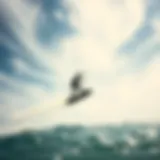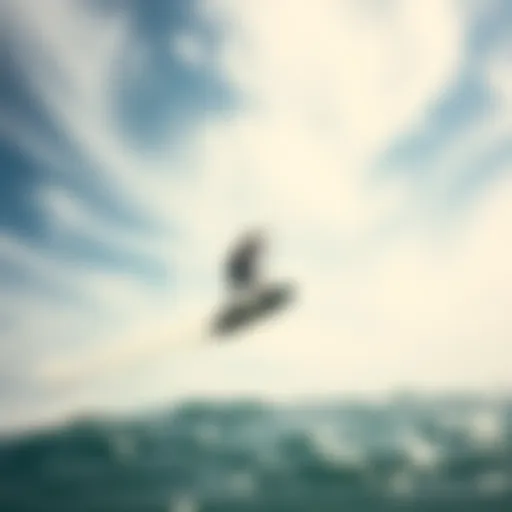Exploring the Tourmaline Surf Report for Kiteboarding
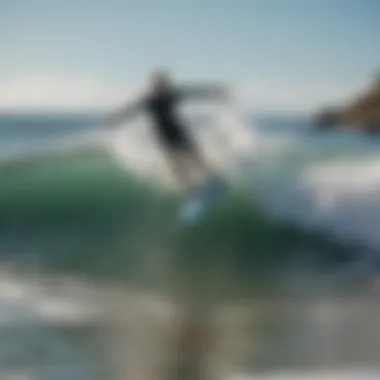

Intro
The significance of a reliable surf report cannot be overstated, especially for kiteboarders navigating the ever-changing waters of Tourmaline Beach. Understanding the conditions that parade across the ocean's surface is not only vital for maximizing performance but also for ensuring safety. Tailored for kiteboarders of various skill levels, this analysis focuses on making sense of the Tourmaline Surf Report - an essential tool that brings the surf environment into clearer focus.
In the sections to follow, we will dissect various elements that contribute to a successful kiteboarding session at Tourmaline. From gear selection to prevailing weather patterns, knowledge is the key to transforming a mere outing into a memorable experience.
Stepping into the depths of what the Surf Report offers, we'll also explore techniques kiteboarders should employ to read the conditions effectively. In a sport where the ocean's temperament can change in the blink of an eye, being informed not only enhances performance but can prevent hazardous situations. Let’s navigate through the subsequent sections with keen interest and readiness to absorb essential insights.
Understanding the Tourmaline Surf Report
The Tourmaline Surf Report isn't just a set of numbers tossed around like confetti; it stands as a crucial tool for those who chase the waves. For kiteboarders, instructors, and even the casual beachgoer, understanding this report can mean the difference between a thrilling day on the water and a disappointing outing. It combines various elements, including wave height, wind speed, and tide predictions, to create a comprehensive picture of the surf conditions.
Embracing the surf report is about recognizing its purpose: to inform and prepare individuals for what lies ahead in the ocean. This knowledge is vital, especially for the more adventurous spirits who engage in kiteboarding. A misread report can lead to tricky performances and diminished safety, which is no small matter when you're out there battling the elements.
Additionally, understanding the historical context of surf reports aids in realizing their evolution and growing importance. As advancements in technology and weather forecasting have progressed, so too has the sophistication of these reports. Those who appreciate the intricacies will find themselves with a tactical advantage on the water.
Definition and Purpose
To dive into the specifics, the Tourmaline Surf Report serves a simple yet profound purpose—it's about sharing essential data that empowers riders to make informed choices. The report typically includes essential metrics like wave height, swell direction, wind strength, and even temperature. Each of these elements plays a significant role in shaping the surf experience. For instance, wind can drastically alter wave conditions and can either enhance or hinder the ride.
In a nutshell, the main definition of the Tourmaline Surf Report is that it's a guide—an indispensable resource that allows kiteboarders to align their plans efficiently. When one can lay eyes on accurate and timely information, it can change the course of the day on the water.
Historical Context
Considering the historical context, the evolution of surf reporting tells a tale of adaptation and innovation. Surf reports have progressed from simple observations by local surfers jotting down notes, to sophisticated algorithms that crunch data from multiple sources, including buoys and meteorological satellites. In the early days, surfers might have guessed the conditions based on their own experiences or camaraderie. Nowadays, real-time data availability through various apps and websites allows for a more localized and accurate understanding, minimizing the risk of miscommunication.
The story of the Tourmaline Surf Report is also interwoven with community experiences, where local knowledge and expertise have molded how data is interpreted and utilized. As more people take an interest in the nuances surrounding surf conditions, the demand for accurate reporting naturally grew, leading to a richer tapestry of data-driven insights.
"Understanding your surf report isn't just a skill; it's an art form that can elevate any session into a memorable experience."
As we journey through this article, each section will build on these foundational insights, providing a thorough understanding of how the Tourmaline Surf Report can be effectively utilized for optimal kiteboarding adventures.
Key Components of the Surf Report
Understanding the key components of the Tourmaline Surf Report is crucial for kiteboarders who wish to maximize their experience on the water. These components provide insights that inform decisions regarding when to kiteboard, what gear to use, and how to stay safe. Each element is interconnected and plays a vital role in shaping the surf conditions.
Wave Height and Period
Wave height is one of the most talked about metrics in the surf report. It tells you how tall the waves are likely to be at any given time, which can greatly influence your riding experience. For instance, if the forecast indicates waves of over six feet, that can challenge even seasoned kiteboarders. Some riders thrive on those big waves, while others might prefer a calmer session with waves around two to three feet.
The wave period, which is the time between consecutive wave crests, is just as important. A longer wave period can mean more powerful and better-formed waves. Kiteboarders often find that they are able to catch these waves more easily, allowing for smoother rides.
"For kiteboarders, understanding wave height and period isn’t just about comfort; it’s directly tied to safety and performance. Good riders know how to read the waves like a book."
Wind Conditions
Next up are wind conditions. Wind is not just a minor detail; it dictates the kite's performance and how well you can navigate the water. Generally, wind speed and direction are critical factors. A steady offshore wind can provide excellent conditions for flying a kite, but if the wind shifts and becomes gusty or inconsistent, it can turn the session into something less enjoyable and more dangerous.
For kiteboarders, reading the wind forecast should be part of the pre-session checklist. It is essential to recognize the local wind patterns, as these can change quite rapidly. Knowing whether to expect side onshore, offshore, or crosswinds helps in planning the ideal launch and landing spots. Checking the wind conditions regularly can make the difference between a thrilling session and one that ends in frustration.
Tide Predictions
The tide can turn the ocean into a different playground altogether. Tides influence wave shapes, currents, and even marine hazards, all of which affect kiteboarding directly. High and low tides bring about various changes along the shoreline. For instance, some spots can become dangerous at low tide due to exposed rocks or shallow areas. Conversely, high tide can increase the swell, making for more exciting rides but can also mean stronger currents.
Kiteboarders must stay informed about tide predictions. When planning sessions, checking the tide chart is critical to ensure optimal conditions and avoid dangerous areas. Recognizing how tide cycles interact with the wind and wave height is crucial for any kiteboarder looking to enhance their skills while keeping safety top of mind.
In summary, the key components of the Tourmaline Surf Report—wave height and period, wind conditions, and tide predictions—are not just statistics. They are vital pieces of information that empower kiteboarders to make informed choices that can enhance their experiences on the water.
Local Influences on Surf Conditions
When it comes to kiteboarding, the local conditions can often make or break a session. Understanding how various elements play into the surf conditions directly impacts both safety and performance on the water. At Tourmaline Beach, unique local influences, such as geographical features and seasonal variations, can significantly alter the experience for kiteboarders. Grasping these nuances helps enthusiasts, instructors, and travelers alike to better plan their outings and optimize their time on the water.
Geographical Features
The geographical layout of Tourmaline Beach is no small matter when it comes to surf conditions. Nestled within a specific coastal setting, the beach is flanked by cliffs and rocky outcrops that can lend themselves to varying wave patterns. For instance, the southwest-facing orientation may catch waves differently compared to areas that face directly east. If you’ve ever tried to ride during a South swell when wind energy is funneled through these formations, you’d know how critical this aspect can be.
Some key elements to consider include:
- Reef Breaks: These can create powerful waves but also pose hazards for less experienced riders. Knowing where these shoals are positioned can help mitigate risks.
- Wind Barriers: Local structures, natural or human-made, can affect wind patterns and strength, which is crucial for kiteboarders pushing their limits. A decent gust can turn a flat day into a thrilling experience!
- Sandbanks and Tides: Shifting sand can dramatically alter the landscape, changing the way waves break and how water flows as tides come in or out. Monitoring these changes can spell the difference between a mellow day and one filled with adrenaline.
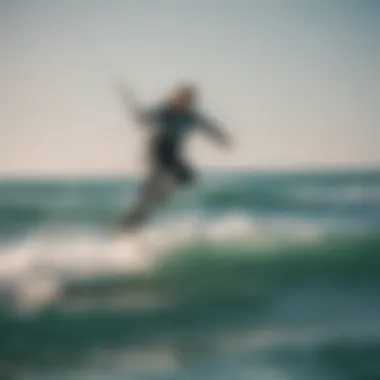

Understanding Tourmaline’s unique geographical features equips kiteboarders to make more informed decisions before heading out. Locals often speak of how certain spots are ‘gold’ at high tide and what works best during different swell directions. Absorbing that local knowledge gives surfers the upper hand over the fickle nature of the ocean.
Seasonal Variations
The surfing experience at Tourmaline Beach also goes through seasonal cycles, each bringing distinct challenges and rewards. For kiteboarders, recognizing how seasonal variations can affect wind patterns, swell height, and overall conditions is indispensable. Each season tells its own tale, and understanding it enhances not just performance but the overall enjoyment of the sport.
Consider these seasonal impacts:
- Winter Swells: Often, during the winter months, larger swells arrive from the northern Pacific. This can bring about thrilling yet daunting waves. Although the experience at Tourmaline can be incredible, it’s crucial to evaluate skill level against wave height carefully.
- Summer Winds: Typically, summer ushers in consistent onshore winds ideal for kiteboarding. Yet, pesky morning fog can obscure visibility, making early sessions tricky. Local wisdom often advises waiting for the sun to burn off those clouds before setting sail.
- Transitions: The change of seasons also leads to inconsistency in patterns. Early spring can flip from gusty winds one week to glassy conditions the next. Being aware that such variability exists can save budding kiteboarders from getting wet for the wrong reasons.
In summation, the local influences on surf conditions at Tourmaline Beach are a medley of geographical wonders and seasonal shifts. Kiteboarders who tune into these details are likelier to ride the waves safely and effectively, crafting memorable sessions over simply surviving them. The more you know about what’s working beneath your board and above your head, the more rewarding today’s ride will be tomorrow.
Interpreting the Data
Interpreting the data from the Tourmaline Surf Report is a fundamental skill that every kiteboarder should possess. When you dive into this report, it's not just a casual glance; it's akin to reading a treasure map that leads you to waves worth riding. This data acts like a compass, guiding you through the complexities of surf conditions, tide levels, and wind patterns. Understanding these elements is essential for planning your kiteboarding sessions and ensuring your safety on the water.
Reading the Report
When you look at the surf report, there are several key aspects to pay attention to:
- Wave Height: This is often presented in feet. Knowing the height can determine whether the conditions are suitable for your skill level.
- Wave Period: This indicates how much time passes between waves, which can affect the experience on the water. A longer period typically means more powerful swells.
- Wind Speed and Direction: These are crucial factors because the wrong wind can turn a pleasant session into a dangerous one. A side-shore wind, for example, is usually preferred.
- Tide Information: Tides can significantly influence wave quality, with some breaks working better on high tide or low tide.
Reading these elements correctly can prevent unwelcome surprises when you hit the water. A quick glance might say it’s a great day out there, but without careful analysis, you could end up in conditions that aren’t fit for you. Kiteboarders often make a habit of jotting down observations and comparing them to actual experience, refining their skills over time.
Common Misinterpretations
Interpreting surf data isn’t foolproof. Often kiteboarders misread specific metrics, leading to misguided decisions. For instance:
- Underestimating Wind Impact: A common mistake is assuming wind speed is less critical than wave height. In fact, high winds can create challenging hazards, even with manageable waves.
- Ignoring Tidal Effects: Some may think tides are unimportant, but they can make a significant difference in surf conditions. For example, a spot that looks great at high tide can be nearly useless at low tide.
- Neglecting the Wave Period: Many riders assume that if wave height looks good, they’ll have a great session, but if the period is too short, they might find themselves struggling against chaotic swells instead.
To avoid such pitfalls, it’s beneficial to engage with the kiteboarding community. Veteran riders often share insights on how to interpret these reports accurately. Online forums, like those on Reddit, can be excellent resources to gain knowledge from diverse kiteboarders' experiences.
"The ability to read surf reports isn’t just about numbers; it’s about understanding your environment and making informed decisions that can enhance or ruin your day on the water."
In summary, being skilled at interpreting data from the Tourmaline Surf Report can elevate your kiteboarding experience, making it safer and more enjoyable. Constant learning and keen observation will help you optimize your water time effectively.
Practical Applications for Kiteboarders
Understanding the various practical applications of the Tourmaline Surf Report significantly enhances the kiteboarding experience. This resource is not just numbers on a screen; it’s a lifeline that can dictate the success or failure of your session. By interpreting the report accurately, kiteboarders can make informed decisions, ensuring they chase the waves on days with optimal conditions.
Session Planning
When it comes to planning a kiteboarding session, timing is everything. The Tourmaline Surf Report provides crucial insights like wave height, swell behavior, and wind speed, all of which dictate if you’ll have a day of exhilarating rides or if the conditions are best left untouched. Understanding when to go is also about grasping the tide cycles. For instance, some kiteboarders prefer kiteboarding at high tide, when water levels peak and the surf can be juicier.
Here’s a breakdown of how to leverage the report for session planning:
- Identify Ideal Conditions: Look for days when wind speeds are between 12 to 25 knots. This range enables a balance between control and excitement.
- Check Tides: A favorable tide can amplify wave power, while an unfavorable one might expose dangerous underwater hazards.
- Local Knowledge: Each kiteboarder brings their own experience to the table. Chat with other local riders to see if they have tips on timing your sessions. Often, the best days aren't just defined by weather; they are marked by the stories of those who ride there.
Planning isn't merely about checking a box; it's an art that hinges often on being proactive rather than reactive.
Safety Considerations
Safety cannot be overstated when kiteboarding, especially as conditions can shift rapidly. Using the Tourmaline Surf Report as a guiding tool allows kiteboarders to assess potential hazards and make smart choices on the water.
Here’s what to bear in mind:
- Wind Patterns: Sudden shifts in wind can lead to dangerous situations. Understanding prevailing winds helps kiteboarders prepare for turbulence.
- Water Conditions: Reports give insight into ocean temperature and currents, which play a pivotal role in safety. Cold water can sap energy quickly, while strong currents can overpower even seasoned riders.
- Weather Changes: Be vigilant about impending weather reports. Storm clouds can roll in unannounced, making for choppy waters and limited visibility. Pay attention to detailed forecasts that warn of thunderstorms.
"Grit in the gears isn’t always bad; it can be a signal to take a break, regroup, and plan for a better session next time."
By using the Tourmaline Surf Report effectively, kiteboarders can enhance their safety, ensuring that their experiences are not just thrilling but also secure.
The Role of Technology in Surf Reporting
In today's fast-paced world, technology plays an integral role in shaping various aspects of our lives, including the realm of surf reporting. In the context of the Tourmaline Surf Report, the advancements in technology have not only revolutionized how data is collected, but also how it is interpreted and utilized by kiteboarders.
Accurate and timely surf reports are crucial for riders who seek the best conditions for their sessions. With the right technology at our fingertips, these reports become an indispensable tool, guiding enthusiasts and professionals alike to navigate the waters safely and effectively.
Data Collection Methods
When it comes to collecting surf-related data, multiple methods are employed to ensure the information is precise and reliable. Various sensors and equipment are deployed along the coastline to monitor different environmental elements. These include:
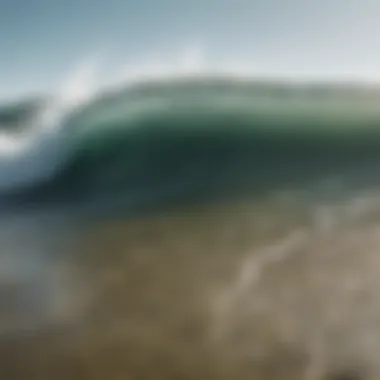

- Buoys: Located offshore, buoys measure wave height, period, and water temperature. They provide ongoing updates, which are crucial for kiteboarders to assess the real-time conditions at Tourmaline Beach.
- Weather Stations: These are strategically placed to capture wind speed and direction, air pressure, and temperature. Knowledge of wind patterns is vital for kiteboarders, as they directly impact the ride.
- Satellite Imagery: Satellite technology offers insights into swell patterns and can track ocean currents. This data helps riders anticipate how the surf will behave throughout the day.
The synthesis of data from these various sources allows for a comprehensive surf report that can be trusted. Kiteboarders can feel confident that they are getting accurate information before heading out. It’s like having a seasoned surfer at your side, keeping you in the loop.
Emerging Technologies
As technology continues to advance, new innovations are finding their way into surf reporting. These developments promise to enhance the quality and accuracy of the information accessible to riders. Some notable examples include:
- Machine Learning Algorithms: By analyzing historical data, these algorithms can predict wave conditions with an impressive degree of accuracy. Riders are now able to gain insights into when the best times to surf might be, based on patterns from previous years.
- Mobile Applications: With the rise of smartphones, various apps now provide real-time updates on surf conditions. Riders can receive notifications alerting them to changes in the weather and surf, ensuring they are always in the know.
- Drones: The use of drones for aerial photography can offer a bird's-eye view of the surf conditions. They can capture footage of wave breaks and shoreline changes, which is invaluable for understanding the local surf environment.
These emerging technologies elevate the overall kiteboarding experience, allowing enthusiasts to plan their sessions with greater accuracy and information. By leveraging such innovations, participants in the sport can optimize their time on the water, maximizing enjoyment while minimizing risks.
In summary, adopting advanced technologies in surf reporting not only empowers kiteboarders but also fosters a community that values safety and informed decision-making. As the surf landscape continues to evolve, staying attuned to technological advancements can only enhance this thrilling sport.
Community Perspectives
When it comes down to the nitty-gritty of surfing or kiteboarding, the community perspective can make all the difference. You see, it's not just about individual experiences out on the water, but also about sharing knowledge and forming a collective understanding of the conditions at play. This sense of community encourages kiteboarders to relay vital information, which can be especially beneficial in regions like Tourmaline Beach, where conditions can shift like a chameleon.
Expert Opinions
Expert opinions carry weight within the kiteboarding community. These insights come from seasoned individuals who have spent years perfecting their craft. They often analyze surf conditions through various lenses, such as their personal riding styles and experiences. Their knowledge isn't just thrown out casually—instead, they’ve honed it through hours of work, observation, and sometimes trial and error.
For instance, local instructors often provide feedback on the nuances of the Tourmaline Surf Report. They might emphasize particular wind patterns, identifying how even a slight change can affect the ride. Here, it’s valuable to listen to experienced practitioners and not just rely on raw data.
Rider Experiences
Rider experiences add an additional layer to understanding surf reports. Each individual brings their own unique encounters, preferences, and insights. Stories shared amongst fellow riders can illuminate patterns in conditions that data alone may not reveal. For example, a kiteboarder may recount how the current feels on a breezy day, while another could provide insights on wave timings that suit different skill levels.
- Shared Experiences: Riders often discuss critical aspects, like:
- Community Feedback: Engaging in platforms like Facebook or Reddit groups allows kiteboarders to ask:
- Specific setups that work best depending on the day’s conditions.
- Lessons learned from unexpected weather changes on the water.
- "What were the wave conditions like last weekend? Any tips for the best spots?"
- "How do you manage during high tides? Any tricks to share?"
In summary, community perspectives are more than anecdotal; they are essential for weaving together a comprehensive view of what to expect out on the water. A kiteboarder's ability to make informed decisions increases fundamentally when they tap into the rich tapestry of experiences shared within the community. This dialogue not only empowers kiteboarders but also builds stronger bonds among those who share the same watery playground.
"Knowledge is power, especially when it’s shared in a close-knit community. It’s about everyone catching the right wave together."
Ultimately, when kiteboarders embrace the collective experience offered by the community, they elevate not just their individual rides but contribute to an enriched kiteboarding culture at Tourmaline Beach.
Environmental Considerations
The shifting sands of the environmental landscape directly color the experience of kiteboarders and surfers alike. The conditions at Tourmaline Beach are not static; they are influenced by a myriad of environmental factors that kiteboarders must consider. Promoting awareness of these conditions can ensure a safe, enjoyable session while also preserving the natural beauty of the area. Understanding these elements helps in making informed decisions that intertwine recreation with environmental stewardship.
Impact of Climate Change
Climate change is no longer a distant worry; it's here, and it impacts shorelines across the globe. Rising sea levels, changing weather patterns, and increasing water temperatures all play a role in shaping local surf conditions. At Tourmaline Beach, kiteboarders may notice alterations in the swell patterns and tide behavior, which could impact safety and performance.
The effects on marine life can also create indirect consequences for kiteboarding enthusiasts. A decline in fish populations, due to warming waters or acidification, can change the ecosystem significantly. As a result, the behavior of marine fauna may affect prevailing wind patterns, making conditions unpredictable.
Recognizing these shifts is crucial. It's not just about having fun out there; it's about understanding how our activities affect the ocean. Keeping tabs on local climate reports can provide insights on what to expect during your session.
"Sailing against climate change isn’t an option; every rider holds the oars of change in their hands."
Conservation Efforts
In light of these challenges posed by climate change, many organizations are stepping up to preserve the delicate balance of the coastal ecosystem at Tourmaline Beach. Conservation initiatives often center around strategies like habitat restoration and pollution control, working to ensure future generations can enjoy the thrill of kiteboarding in a vibrant environment.
Efforts might include:
- Beach cleanups: Regular events help remove debris that could pose hazards to both riders and marine life.
- Monitoring water quality: Local groups often conduct tests to assess the health of the water, which can influence not only the flora and fauna but also the kiteboarding experience itself.
- Awareness campaigns: Such campaigns educate the community about sustainable practices, encouraging riders to respect local wildlife and avoid damaging the environment.
Each kiteboarder can contribute to these initiatives, whether through participation in local events or adopting more sustainable practices in their own routines. Supporting these efforts is vital—not just for the health of the beach but for maintaining enjoyable conditions for all watersports enthusiasts. Community involvement in conservation efforts creates a ripple effect, making the surf report not just a tool for rider performance but a cornerstone for environmental responsibility.
Comparative Analysis with Other Surf Reports
Examining the Tourmaline Surf Report in the context of other surf reports can be incredibly enlightening. Surf reports are not just about the numbers; they tell a story about the conditions that kiteboarders can expect. When analyzing Tourmaline’s report alongside similar resources, it becomes clear that local nuances play a significant role in shaping the experience for riders.
Some regions may experience more consistent swells due to geographical positioning, while others might be affected by currents that vary dramatically with the tide. By understanding these regional differences, riders can tailor their sessions to optimize conditions, ensuring a safer and more enjoyable experience.
Regional Differences
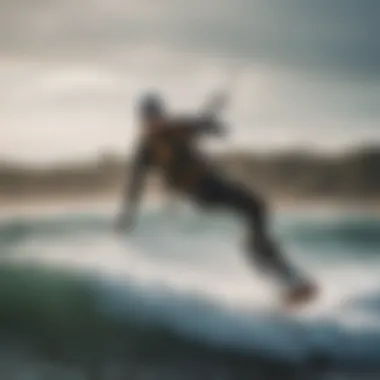

When comparing the Tourmaline Surf Report with those from other popular kiteboarding spots, various elements stand out. For instance, locations like Kite Beach in Cape Town or Cabarete in the Dominican Republic offer different swell patterns and wind conditions.
- Wave Height Variability: Locations can differ vastly in wave heights. For example, Tourmaline might typically have smaller surf due to its southern Californian location, while places like Pismo Beach can see larger swells. This means skills and equipment vary too.
- Wind Directions: The wind's direction is crucial. At Tourmaline, northerly to north-westerly winds can create ideal conditions. Yet in other regions, such as Maui, trade winds dominate, leading to a completely different riding experience.
- Local Conditions: Aspects such as flora and fauna can alter water behavior. For Tourmaline, there are unique underwater formations that may not exist in Hawaii, impacting how waves break and providing riders with distinct conditions to navigate.
The beauty of surf reports lies in knowing these differences, as they are vital for session planning. A kiteboarder using the Tourmaline report but traveling to a different location would need to adjust their approach based on the findings from that area’s reports.
Best Practices
When using surf reports for planning kiteboarding sessions, some best practices can substantially enhance your experience:
- Cross-reference Reports: It is beneficial to scout several surf reports. Not only does this validate the information, but it also gives a broader view of conditions. Websites like en.wikipedia.org and britannica.com provide additional context and data concerning surfing worldwide.
- Monitor Seasonal Trends: Keeping an eye on data over time enables kiteboarders to identify patterns and prepare better for specific seasons. For example, certain times of the year may be better for larger swells at Tourmaline, while others might be calmer.
- Engage with Local Communities: Different places have unique cultures around their watersports. Joining forums on Reddit or Facebook can introduce you to local insights and personal experiences from other riders that you won't find in the reports themselves. These nuances are often where the real knowledge lurks.
"The difference between knowing and understanding the surf conditions can be as vast as the ocean itself."
In summary, a comparative analysis with other surf reports paints a more comprehensive picture of what kiteboarders can expect. Understanding these elements not only enhances preparation but also contributes to a safer, more informed riding experience.
Future Trends in Surf Reporting
As technology continues to advance at breakneck speed, the world of surf reporting is entering an era of unprecedented evolution. Understanding these future trends is pivotal for kiteboarders and surf enthusiasts who rely on accurate information to enhance their experiences at the beach. These developments not only affect how information is gathered but also how it is interpreted and utilized. By delving into the potential transformations in surf reporting, riders can harness these advancements for their benefit.
AI and Predictive Analytics
Artificial Intelligence (AI) is rapidly reshaping various fields, and surf reporting is no exception. With sophisticated algorithms that analyze vast amounts of data, the potential to improve forecasting accuracy is monumental. For kiteboarders, this means getting insightful predictions based on real-time conditions. AI systems can examine historical data, current conditions, and varying factors like weather updates and oceanic shifts to generate tailored forecasts.
- Enhanced Predictive Capabilities: Unlike traditional methods, AI can process numerous inputs simultaneously. This helps in predicting not just wave heights but also the intensity and consistency of wind, which is essential for kiteboarding.
- User-Centric Customization: As more kiteboarders embrace these tech innovations, systems can learn user preferences, providing personalized reports that cater to individual skill levels and favored surf conditions.
- Reduced Human Error: Reliance on machine learning reduces the likelihood of errors common in manual assessments of surf conditions. Thus, making it safer for users who depend on this information for their sessions.
User-Focused Innovations
The future of surf reporting isn't merely about advanced algorithms; it also hinges on the user experience. Innovations focused on the end user are paving the way for more accessible and comprehensible data. Users want actionable insights, and surf report applications must deliver just that.
- Mobile Applications: With the ubiquity of smartphones, customized surf reporting apps are becoming essential. These apps provide real-time notifications about changing conditions, which is vital for kiteboarders who want to seize every opportunity for a great session.
- Interactive Data Visualization: Instead of presenting plain numerical data, the future will see more dynamic and interactive data visualization tools. These will allow users to grasp complex conditions quickly and make informed decisions with ease.
- Community Feedback Loops: Incorporating feedback from users to refine reporting accuracy and relevance. This creates a community-driven approach where kiteboarders can contribute to enhancing surf reporting, ensuring that insights are relevant for those on the water.
By fully embracing these trends, surfers and kiteboarders will not just adapt to an ever-changing environment; they will thrive in it.
In summary, future trends in surf reporting hold exciting prospects for the kiteboarding community. From AI-driven analytics to innovations tailored for user experience, these developments promise to elevate the way riders access and interpret vital surf data. Thus, staying informed about these changes is not just a recommendation; it's a necessity for making the most of every seaside adventure.
Case Studies: Successful Use of the Surf Report
In the realm of kiteboarding, understanding local surf conditions can mean the difference between an exhilarating day on the water and a potentially hazardous situation. The Tourmaline Surf Report serves not just as a collection of numbers and jargon; it embodies real-world implications for riders. This section explores how various kiteboarders have harnessed the information available in the surf report effectively, illustrating the tangible benefits derived from its use.
Local Success Stories
Over the past few years, there have been numerous instances where local riders have leveraged the Tourmaline Surf Report for their kiteboarding sessions. One prominent example is Claire Hollis, a kiteboarding enthusiast based near Tourmaline Beach. Before each session, Claire checks the report meticulously.
"I always look at the wind speeds and wave periods. They give me a good idea of what to expect on the water," Claire notes, emphasizing that this practice has allowed her to maximize both her safety and enjoyment.
Another case is of a group of friends, known as the "Kite Crew," who often organize weekend trips to the beach. By familiarizing themselves with the report, they manage to schedule their outings during the optimal conditions. Recently, they shared a highlight video showcasing some impressive jumps and tricks. The comments section was flooded with inquiries about their preparation strategy, proving that a well-informed rider not only performs better but also attracts attention.
Lessons Learned
From these success stories, several lessons emerge that enhance one’s understanding of the benefits offered by the surf report. Firstly, having a routine of checking the report can help build a stronger awareness of local conditions. This, in turn, cultivates a level of intuition that is invaluable while out on the water.
Key takeaways include:
- Reliability of Data: Regularly checking updated reports ensures that riders can trust their decisions based on the latest information.
- Shared Knowledge: Riders who discuss and exchange experiences about the report often discover hidden insights that can enhance their sessions, creating a community of informed enthusiasts.
- Adaptability: Conditions can shift rapidly, so flexibility in planning and the willingness to adjust based on the report's updates are crucial for every kiteboarder's success.
In summary, utilizing the Tourmaline Surf Report not only supports informed decision-making but also significantly enriches the kiteboarding experience. Whether it’s about aligning your schedule with optimal conditions or learning from fellow riders, these case studies exemplify how a simple practice can lead to remarkable outcomes on the water.
The End: The Importance of Accurate Surf Reporting
The significance of precise surf reporting cannot be overstated, especially when it comes to enhancing the kiteboarding experience at Tourmaline Beach. Accurate reports serve as a compass for kiteboarders, helping them navigate the ever-changing sea conditions effectively. It isn’t just about having fun on the water; it’s about safety and performance.
Summarizing Key Points
To recap, the Tourmaline Surf Report incorporates several key elements:
- Wave Height and Period: Understanding the height and timing of waves is crucial for kiteboarders as it influences their control and performance.
- Wind Conditions: Wind is the lifeblood of kiteboarding. Knowing its speed and direction can determine whether a session will be enjoyable or hazardous.
- Tide Predictions: Tides affect water levels and currents, which can greatly alter the dynamics of surfing and kiteboarding. A thorough knowledge of the tide schedule helps riders choose the best times to hit the water.
Accurate surf reporting synthesizes these factors into a single, coherent narrative, allowing riders at all skill levels to make informed decisions. Just as an eagle-eyed navigator depends on their instruments, kiteboarders rely heavily on the surf report to guide their adventures.
A Call to Action for Kiteboarders
For kiteboarders aiming to maximize their time on the water, engaging with the surf report actively is essential. Here are a few actions to consider:
- Stay Updated: Regularly check the Tourmaline Surf Report before your sessions. Knowledge is power, and conditions can shift quickly.
- Participate in Community Feedback: Join forums or local social media groups where updates and experiences are shared. Engaging with fellow enthusiasts aids in better understanding the local surf environment.
- Educate Your Peers: Help less experienced kiteboarders learn to interpret the report. This fosters a community of well-informed riders, enhancing safety for everyone.
By taking these steps, kiteboarders can better prepare for their outings and contribute to a safer riding community. In the end, the ocean is as much a partner as it is a challenge, and understanding it through accurate surf reporting is key to unlocking its potential for adventure.
